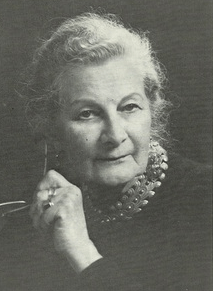Sylvia Holland
Sylvia Holland, also known as Sylvia Moberly-Holland (July 20, 1900 – April 14, 1974) was an illustrator and the second woman to become a storyboard artist for Walt Disney Productions. She worked for Disney in the 1930s and 1940s and is especially known for her work on the 1940 film Fantasia.

Biography
Sylvia Moberly-Holland was born in Ampfield, Great Britain. She worked for a time as a sketch artist for Universal Studios.[1] After seeing Walt Disney's animated film Snow White, she decided she wanted to work for Disney, and in 1938 became the second woman hired into their story department, following Bianca Majolie (up until then, women had only been hired to do inking and painting).[2] Her responsibilities at Disney included story direction, concept art, color studies, timing, and supervising other artists.[3][4]
She worked on concept studies, character designs, backgrounds, and color studies for Fantasia.[3] A musician as well as an artist, she contributed a number story ideas, especially for the segments set to Tchaikovsky's Nutcracker and Beethoven's Pastoral Symphony.[2] She led the story team for the "Waltz of the Flowers" sequence that was set to Tchaikovsky's music, and she later said she enormously enjoyed working on Fantasia, although she had problems with a few of the male artists who did not like taking orders from a woman.[3] Walt Disney held her in high regard, noting that she was "a highly talented artist with a marvelous sense for decoration and color" who "contributed immensely to the good taste and beauty of our pictures".[3]
With Mary Blair, she developed concept art for Baby Ballet, a sequence intended for a planned sequel to Fantasia that never got made.[5][6] She also developed concept art for the 1942 film Bambi and worked on the story for the 1946 film Make Mine Music.[7]
She was laid off from Disney at the end of World War II but continued making art until her death in Tarzana, California.[1]
Holland was also a pioneering breeder of Balinese cats and worked to establish the breed standard in the 1960s and 1970s.[8]
References
- "Sylvia Moberly-Holland. Animation Appreciation Education. Tumblr.com
- Lowery, Paula Sigman. "Worth as Much as a Man: Cracking the Celluloid Ceiling". The Walt Disney Family Museum website, March 6, 2012.
- Canemaker, John. Before the Animation Begins. Disney Editions, 1996, pp. 107-11.
- "Girls at Work for Disney". Glamour, May 1941.
- "Sylvia Holland Search". Tumblr.com.
- "Baby Ballet". Michael Sporn Animation website, Feb. 2, 2009.
- Allan, R. Walt Disney and Europe: European influences on the animated feature films of Walt Disney. Bloomington, Indiana: Indiana University Press, 1999.
- Somerville, Louisa (2007). The Ultimate Guide to Cat Breeds. Edison, N.J.: Chartwell Books, p. 52.